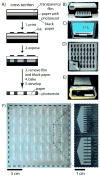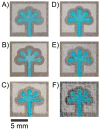FLASH: a rapid method for prototyping paper-based microfluidic devices
- PMID: 19023478
- PMCID: PMC3065062
- DOI: 10.1039/b811135a
FLASH: a rapid method for prototyping paper-based microfluidic devices
Abstract
This article describes FLASH (Fast Lithographic Activation of Sheets), a rapid method for laboratory prototyping of microfluidic devices in paper. Paper-based microfluidic devices are emerging as a new technology for applications in diagnostics for the developing world, where low cost and simplicity are essential. FLASH is based on photolithography, but requires only a UV lamp and a hotplate; no clean-room or special facilities are required (FLASH patterning can even be performed in sunlight if a UV lamp and hotplate are unavailable). The method provides channels in paper with dimensions as small as 200 microm in width and 70 microm in height; the height is defined by the thickness of the paper. Photomasks for patterning paper-based microfluidic devices can be printed using an ink-jet printer or photocopier, or drawn by hand using a waterproof black pen. FLASH provides a straightforward method for prototyping paper-based microfluidic devices in regions where the technological support for conventional photolithography is not available.
Figures



References
Publication types
MeSH terms
Grants and funding
LinkOut - more resources
Full Text Sources
Other Literature Sources

